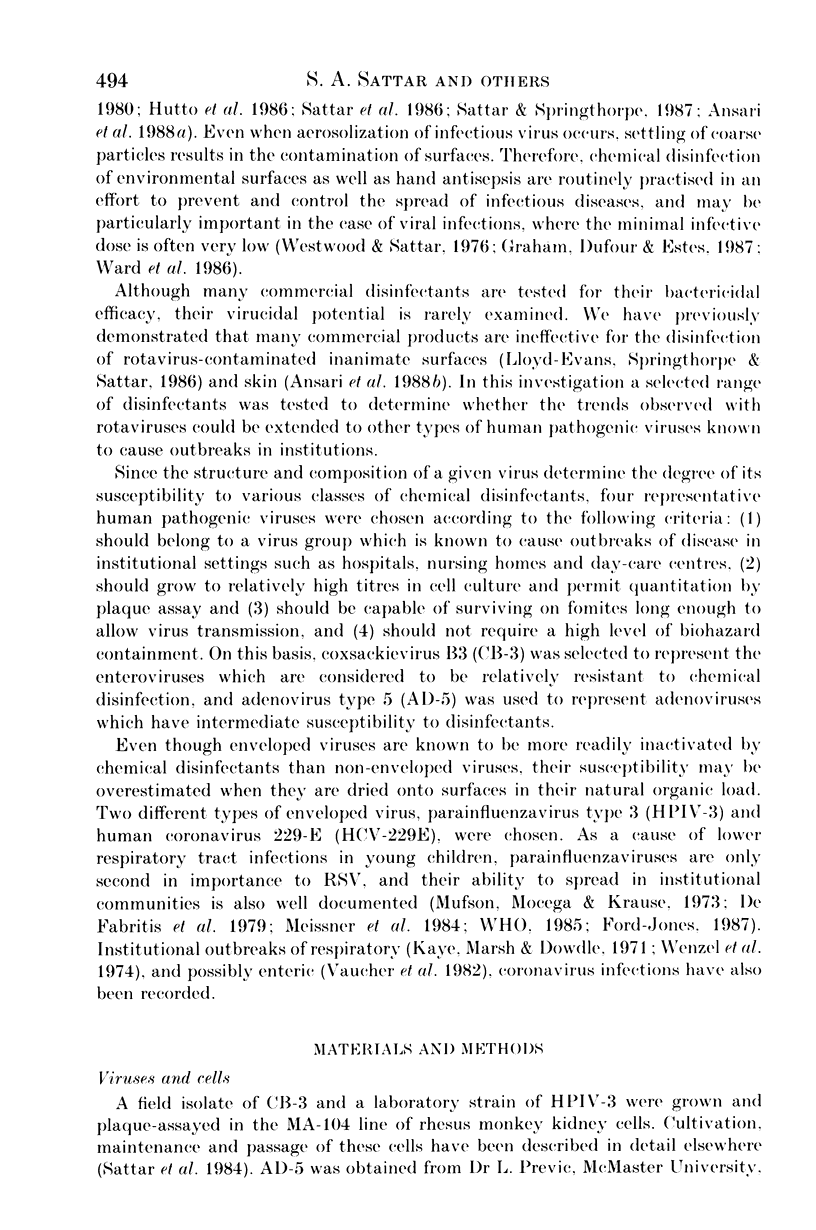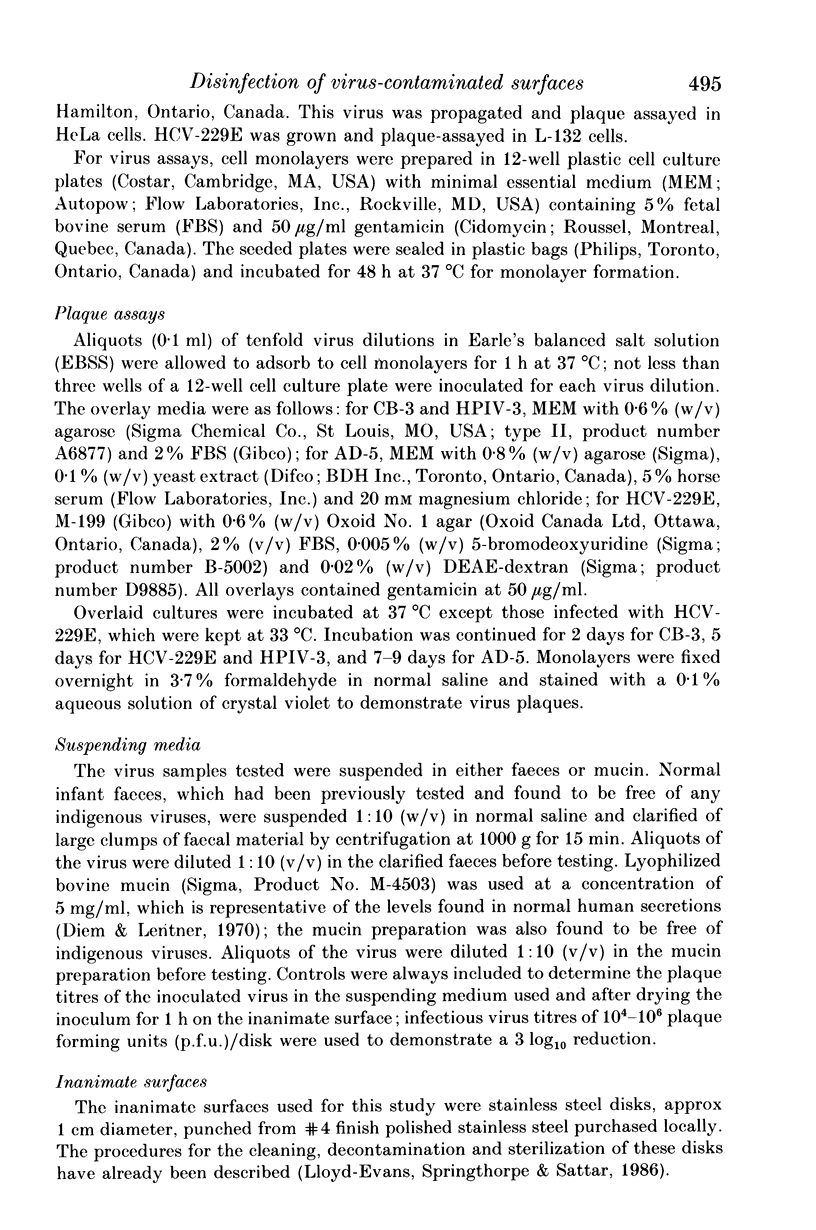Abstract
The chemical disinfection of virus-contaminated non-porous inanimate surfaces was investigated using coxsackievirus B3, adenovirus type 5, parainfluenza virus type 3 and coronavirus 229E as representatives of important nosocomial viral pathogens. A 10 microliter amount of the test virus, suspended in either faeces or mucin, was placed onto each stainless steel disk (about 1 cm in diameter) and the inoculum allowed to dry for 1 h under ambient conditions. Sixteen disinfectant formulations were selected for this study based on the findings of an earlier investigation with a human rotavirus. After 1 min exposure to 20 microliters of the disinfectant, the virus from the disks was immediately eluted into tryptose phosphate broth and plaque assayed. Using an efficacy criterion of a 3 log10 or greater reduction in virus infectivity titre and irrespective of the virus suspending medium, only the following five disinfectants proved to be effective against all the four viruses tested: (1) 2% glutaraldehyde normally used as an instrument soak, (2) a strongly alkaline mixture of 0.5% sodium o-benzyl-p-chlorophenate and 0.6% sodium lauryl sulphate, generally used as a domestic disinfectant cleaner for hard surfaces, (3) a 0.04% solution of a quaternary ammonium compound containing 7% hydrochloric acid, which is the basis of many toilet bowl cleaners, (4) chloramine T at a minimum free chlorine level of 3000 p.p.m. and (5) sodium hypochlorite at a minimum free chlorine concentration of 5000 p.p.m. Of those chemicals suitable for use as topical antiseptics, 70% ethanol alone or products containing at least 70% ethanol were ineffective only against coxsackievirus B3. These results emphasize the care needed in selecting chemical disinfectants for routine use in infection control.
Full text
PDF












Selected References
These references are in PubMed. This may not be the complete list of references from this article.
- Ansari S. A., Sattar S. A., Springthorpe V. S., Wells G. A., Tostowaryk W. Rotavirus survival on human hands and transfer of infectious virus to animate and nonporous inanimate surfaces. J Clin Microbiol. 1988 Aug;26(8):1513–1518. doi: 10.1128/jcm.26.8.1513-1518.1988. [DOI] [PMC free article] [PubMed] [Google Scholar]
- Drulak M., Wallbank A. M., Lebtag I. The relative effectiveness of commonly used disinfectants in inactivation of echovirus 11. J Hyg (Lond) 1978 Aug;81(1):77–87. doi: 10.1017/s002217240005378x. [DOI] [PMC free article] [PubMed] [Google Scholar]
- Drulak M., Wallbank A. M., Lebtag I., Werboski L., Poffenroth L. The relative effectiveness of commonly used disinfectants in inactivation of coxsackievirus B5. J Hyg (Lond) 1978 Dec;81(3):389–397. doi: 10.1017/s0022172400025274. [DOI] [PMC free article] [PubMed] [Google Scholar]
- Hutto C., Little E. A., Ricks R., Lee J. D., Pass R. F. Isolation of cytomegalovirus from toys and hands in a day care center. J Infect Dis. 1986 Sep;154(3):527–530. doi: 10.1093/infdis/154.3.527. [DOI] [PubMed] [Google Scholar]
- Jordan F. T., Nassar T. J. The survival of infectious bronchitis (IB) virus in an iodophor disinfectant and the influence of certain components. J Appl Bacteriol. 1973 Jun;36(2):335–341. doi: 10.1111/j.1365-2672.1973.tb04111.x. [DOI] [PubMed] [Google Scholar]
- Kaye H. S., Marsh H. B., Dowdle W. R. Seroepidemiologic survey of coronavirus (strain OC 43) related infections in a children's population. Am J Epidemiol. 1971 Jul;94(1):43–49. doi: 10.1093/oxfordjournals.aje.a121293. [DOI] [PMC free article] [PubMed] [Google Scholar]
- Lloyd-Evans N., Springthorpe V. S., Sattar S. A. Chemical disinfection of human rotavirus-contaminated inanimate surfaces. J Hyg (Lond) 1986 Aug;97(1):163–173. doi: 10.1017/s0022172400064445. [DOI] [PMC free article] [PubMed] [Google Scholar]
- Mahnel H. Resistenzunterschiede zwischen Viren verschiedener Gruppen gegenüber einigen chemisch-physikalischen Dekontaminationsverfahren. Infection. 1979;7(5):240–246. doi: 10.1007/BF01648934. [DOI] [PubMed] [Google Scholar]
- Meissner H. C., Murray S. A., Kiernan M. A., Snydman D. R., McIntosh K. A simultaneous outbreak of respiratory syncytial virus and parainfluenza virus type 3 in a newborn nursery. J Pediatr. 1984 May;104(5):680–684. doi: 10.1016/s0022-3476(84)80943-9. [DOI] [PubMed] [Google Scholar]
- Nakao J., Hess R. G., Bachmann P. A., Mahnel H. Zur Widerstandsfähigkeit und Inaktivierung des Virus der übertragbaren Gastroenteritis (TGE) der Schwiene. Berl Munch Tierarztl Wochenschr. 1978 Sep 15;91(18):353–357. [PubMed] [Google Scholar]
- Pattison C. P., Boyer D. M., Maynard J. E., Kelly P. C. Epidemic hepatitis in a clinical laboratory. Possible association with computer card handling. JAMA. 1974 Nov 11;230(6):854–857. [PubMed] [Google Scholar]
- Payne S. B., Grilli E. A., Smith A. J., Hoskins T. W. Investigation of an outbreak of adenovirus type 3 infection in a boys' boarding school. J Hyg (Lond) 1984 Oct;93(2):277–283. doi: 10.1017/s0022172400064809. [DOI] [PMC free article] [PubMed] [Google Scholar]
- Poli G., Ponti W., Micheletti R., Cantoni C. Virucidal activity of some quaternary ammonium compounds. Arzneimittelforschung. 1978;28(10):1672–1675. [PubMed] [Google Scholar]
- Sattar S. A., Ijaz M. K., Johnson-Lussenburg C. M., Springthorpe V. S. Effect of relative humidity on the airborne survival of rotavirus SA11. Appl Environ Microbiol. 1984 Apr;47(4):879–881. doi: 10.1128/aem.47.4.879-881.1984. [DOI] [PMC free article] [PubMed] [Google Scholar]
- Sattar S. A., Lloyd-Evans N., Springthorpe V. S., Nair R. C. Institutional outbreaks of rotavirus diarrhoea: potential role of fomites and environmental surfaces as vehicles for virus transmission. J Hyg (Lond) 1986 Apr;96(2):277–289. doi: 10.1017/s0022172400066055. [DOI] [PMC free article] [PubMed] [Google Scholar]
- Sattar S. A., Raphael R. A., Lochnan H., Springthorpe V. S. Rotavirus inactivation by chemical disinfectants and antiseptics used in hospitals. Can J Microbiol. 1983 Oct;29(10):1464–1469. doi: 10.1139/m83-225. [DOI] [PubMed] [Google Scholar]
- Sattar S., Westwood J. C. Viral pollution of surface waters due to chlorinated primary effluents. Appl Environ Microbiol. 1978 Sep;36(3):427–431. doi: 10.1128/aem.36.3.427-431.1978. [DOI] [PMC free article] [PubMed] [Google Scholar]
- Schürmann W., Eggers H. J. Antiviral activity of an alcoholic hand disinfectant. Comparison of the in vitro suspension test with in vivo experiments on hands, and on individual fingertips. Antiviral Res. 1983 Mar;3(1):25–41. doi: 10.1016/0166-3542(83)90012-8. [DOI] [PubMed] [Google Scholar]
- Scott F. W. Virucidal disinfectants and feline viruses. Am J Vet Res. 1980 Mar;41(3):410–414. [PubMed] [Google Scholar]
- Springthorpe V. S., Grenier J. L., Lloyd-Evans N., Sattar S. A. Chemical disinfection of human rotaviruses: efficacy of commercially-available products in suspension tests. J Hyg (Lond) 1986 Aug;97(1):139–161. doi: 10.1017/s0022172400064433. [DOI] [PMC free article] [PubMed] [Google Scholar]
- Vaucher Y. E., Ray C. G., Minnich L. L., Payne C. M., Beck D., Lowe P. Pleomorphic, enveloped, virus-like particles associated with gastrointestinal illness in neonates. J Infect Dis. 1982 Jan;145(1):27–36. doi: 10.1093/infdis/145.1.27. [DOI] [PMC free article] [PubMed] [Google Scholar]
- WALLIS C., BEHBEHANI A. M., LEE L. H., BIANCHI M. THE INEFFECTIVENESS OF ORGANIC IODINE (WESCODYNE) AS A VIRAL DISINFECTANT. Am J Hyg. 1963 Nov;78:325–329. doi: 10.1093/oxfordjournals.aje.a120351. [DOI] [PubMed] [Google Scholar]
- Ward R. L., Bernstein D. I., Young E. C., Sherwood J. R., Knowlton D. R., Schiff G. M. Human rotavirus studies in volunteers: determination of infectious dose and serological response to infection. J Infect Dis. 1986 Nov;154(5):871–880. doi: 10.1093/infdis/154.5.871. [DOI] [PubMed] [Google Scholar]
- Wenzel R. P., Hendley J. O., Davies J. A., Gwaltney J. M., Jr Coronavirus infections in military recruits. Three-year study with coronavirus strains OC43 and 229E. Am Rev Respir Dis. 1974 Jun;109(6):621–624. doi: 10.1164/arrd.1974.109.6.621. [DOI] [PubMed] [Google Scholar]


